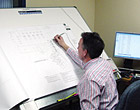
According to Dan Lehman, director of product management, Maxwell Systems Inc., the integration of the estimation software with the job cost software creates a streamlined process helping to increase job profitability.
Technology has helped contractors accomplish this goal, but measuring true profit and loss often proves challenging. The diverse factors and pieces of information from the back office and the field office create a large and diverse pool of facts.
These facts can be an overwhelming source of unusable information or an orderly report that helps drive profitability. It all depends on how the information is filtered.
KNOWLEDGE IS POWER
Software developer Maxwell Systems Inc., King of Prussia, Pa., provides integrated construction software solutions both for the general construction industry and for the electrical, mechanical, plumbing, and HVAC contracting industries.The company’s software system began with its job cost accounting and project management software, which made it possible for contractors to manage every job to help streamline processes and increase profits.
Over time, Maxwell saw the success and growth potential of this software. The company soon realized, however, that to manage a job, the contractor must first win it. Maxwell found an opportunity to expand its market and acquired Quest Solutions and Estimation Inc.
“The result was an end-to-end, seamless estimating and job-cost accounting software solution,” said Dan Lehman, director of product management, Maxwell. “This solution enables construction companies to cover the estimating and job cost accounting process with a single, integrated solution from a single company.”
According to Lehman, the integration of the estimation software with the job cost software creates a streamlined process and helps increase job profitability.
“Although you can use the systems separately, with all the detail on the estimation software, you really need the job cost accounting and project management software to follow through on the estimating promises,” he said.
Along with these software programs, Maxwell Systems has created its own tools that give the user the ability to “further analyze and get a true look at where profit is coming from and where losses are occurring.” These tools allow contractors to use the information and create reports that are tailored to specific informational needs. For example, contractors can evaluate win- loss percentages for sales reps and estimators.
“An employee might be winning 80 percent of the jobs, but it is because they are underbidding and their profit is low,” pointed out Lehman. “Another employee’s win-loss percentage numbers may be comparatively low, [but] their profit margins are much higher because of the way they are bidding.”
Comparing apples to apples helps contractors increase profitability and manage their businesses and staffs more effectively.
PROVING GROUNDS
Northern Air Corp. (NAC) is an HVAC service, construction, and automation contractor based in Vadnais Heights, Minn. The firm has served clients throughout the upper Midwest since its founding in 1992. Now with 120 employees and $40 million in annual revenue, NAC has become one of the largest contractors in the region.NAC credits its growth to a decision made five years ago to abandon longhand estimation in favor of an automated approach powered by Maxwell Systems™ Estimation™ Logistics. According to NAC, by improving estimate accuracy, cutting estimation time in half, and reducing material costs, the company has bid, won, and completed far more projects than it otherwise could have.
For example, NAC competed for a bid to renovate Oak-Land Junior High School, Stillwater, Minn., in the spring of 2006. The $4.3 million project was slated to last two years and included winter work. Had the company produced the estimate longhand, it would have required at least eight days. Using the Estimation Logistics program, NAC produced complete digital takeoffs in four days.
Meeting the deadline with time to spare, NAC won the contract. After winning the job, the next task was to purchase the materials. The company saved money buying materials because of the detailed information outlined within the bid reports.
“The material buy-out was one of the detailed takeoffs,” said Bill Zellmer, project manager and senior estimator at NAC. “When you do this manually, the people in the field do the buy. We took our digital takeoff, sent it to suppliers, and got what we felt was a really good purchase on the material for the project, well in advance of having boots on the ground.”
Using the software, NAC also improved its accuracy in change orders as the project unfolded. The company was able to adjust labor and material costs based on evolving project needs and market prices, and provided both the property owner and general contractor with detailed takeoffs documenting each change, down to the penny.
NAC said that relying on a digital takeoff helped the project manager maintain a firm grasp on where the project was, and where it was heading. “When you get it right upfront, everything else falls into place,” noted Zellmer. “The majority of our effort is upfront in the estimation part of it. When the detail comes out, we can use that to drive a better material purchase. And then we can keep a close eye on the labor and materials throughout the project, and know what direction things are heading.”
During weekly project management meetings, NAC also used the estimating software to compare their original projections to what was actually happening on the jobsite. “We knew if we were heading in the right direction or if we needed to do a little adjustment out in the field,” said Zellmer. “In the end, the job was completed in the spring of 2007, and was on budget.”
Publication Date:02/25/2008


Report Abusive Comment